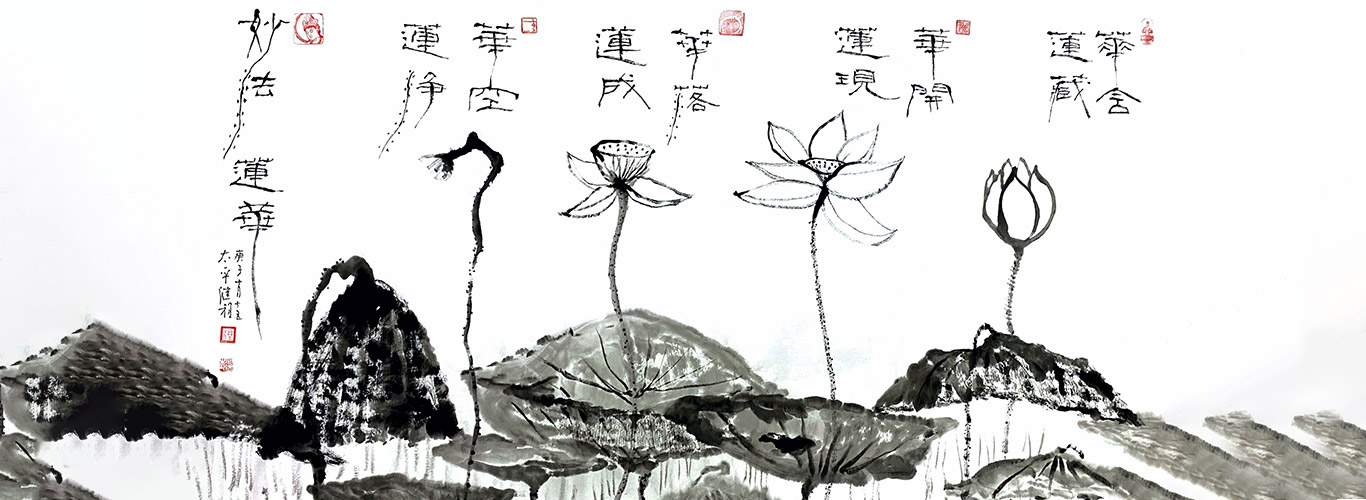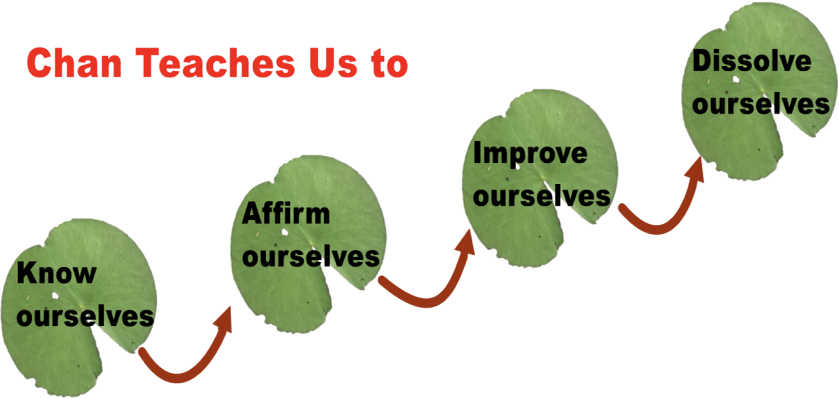Articles
 The artwork by Venerable Chi Chern depicts the blossoming of the lotus, which symbolizes the four elements of emerging Chan wisdom.
The artwork by Venerable Chi Chern depicts the blossoming of the lotus, which symbolizes the four elements of emerging Chan wisdom.| What is Chan? |
Chan is the school of Chinese Buddhism popularly known as “Zen” in Japanese. It is also a term that refers to a way of living or experiencing the world. But ultimately, Chan means direct awakening to interconnectedness and impermanence, and the consequent arising of Buddhist wisdom and compassion. This awakening experience is inexpressible in words.
For this reason, there is a saying, “Chan is not established on words and language;” yet Chan freely uses words and language to benefit the world. The teaching starts with knowing one’s self, but the process of practice leads to a discovery of our interconnectedness with others. Direct personal experience of Chan brings about the actualization of wisdom and compassion, which leads to peace and understanding in the world.
Specifically, the Chan teaching encompasses four key elements: faith, understanding, practice, and awakening. Faith is confidence in oneself and the path. Understanding refers to the insights gained on the path. Practice transforms our negative habits and distorted views. Awakening is the actualization of wisdom and compassion. These four elements are inseparable and mutually inclusive.
Chan Practice in Daily Life
Practice is not something separate from daily living. Proper practice includes cultivating mindfulness, compassion, intuition, and wisdom. Be aware of your changing mental and physical conditions. See how they affect your thoughts, words and actions. In all our actions, we should consider whether our intentions are beneficial to others. Cherish yourself less and others more. If we put other people before ourselves, selfish feelings will not arise as frequently.
Considering others is as much a form of practice as meditation. Sentient beings have their own karma, their own karmic causes and conditions, their own merits and virtues. You cannot change them, nor can you take on the karma of others. Of key importance is your intention. You should sincerely try to help others, whether or not you succeed. Do not do anything that will make you feel tense, tired, or miserable. Do the best you can, but don’t push too hard. Use meditation as a supporting discipline and Buddha’s teaching as your guide.
You can practice in any situation. During your busy day, try to find a few moments to stop, sit, relax, and clear your mind. You need not always sit on a cushion to practice for thirty minutes. You can do your practice anywhere, anytime, at your desk, in a car, bus, or train, right now. Relax your body and mind; let clarity and a gentle smile arise from within; allow your body and mind to refresh itself.
A Brief History of Chan
After the death of the historic Buddha many schools of Buddhism arose, and over time declined. Today there exist two major branches of Buddhism; Theravada, (from the Pali meaning “The School of Elders”) and Mahayana (from the Sanskrit meaning “The Great Vehicle”). Chan belongs to the Mahayana branch of Buddhism.
Tradition has it that Chan was brought to China from India, in the fifth century CE by a monk named Bodhidharma. He is considered the first Patriarch of Chan. The teaching he brought emphasized Dhyana, which roughly translates to meditation in English. The word Chan is the Chinese rendition of the Sanskrit word Dhyana.
Over the next several hundred years, the robe and bowl of the Patriarch of Chan were passed to 5 masters; Huike, Sengcan, Daoxin, Hongren and Huineng. During this time the practices brought from India were adapted to the Chinese culture. Monasteries were constructed and Chan became more and more prevalent throughout China.
With the death of Huineng the robe and bowl of the Patriarchs were not passed down and over time Chan split into Five Houses. Each was named after their founder, and at the time they were not considered separate sects, but more like indications of lineage. Yet over time each developed in their own way, and in modern times these houses have come to be referred to as “schools”. These were the Guiyang school, the Linji school, the Caodong school, the Fayan school and the Yumen school. Of these only the Linji and Caodong are still in existence. The Fayan, Yumen and Guiyang schools, over time, were absorbed into the Linji school, which became the dominant school in China.
Over the centuries Chan saw periods of preeminence and persecution. With the relative peace and prosperity of the Song dynasty (c.960-1300), Chan became the largest sect of Chinese Buddhism. This is often referred to as the golden age of Chan. It was during this time that many classic Chan texts such as the Blue Cliff Record and the Gateless Gate were compiled. It was also during this time that unique meditative practices, such as silent illumination and gong’an, were perfected, developed and codified.
From China, Chan spread to Vietnam as Thien, to Korea as Seon and to Japan as Zen. In Japan, the two remaining schools Linji and Caodong are called Rinzai and Soto respectively. With its emphasis on meditation and simple, practical day to day practice, Chan has had a history of adapting as it has moved from culture to culture, without losing its distinct and recognizable core teachings.
In modern times this process continues in Europe and North America. Through the wisdom and teaching of Eastern masters, such as our founder Master Sheng Yen, Buddha-dharma has sunk roots in the west and it is growing. Through the guidance of Master Sheng Yen’s Western and Eastern Dharma Heirs, and our own practice of Chan, our hope is to help tend this relatively new shoot of Buddhism as it develops in the West.

DDMLA
FOLLOW US
CONTACT US
